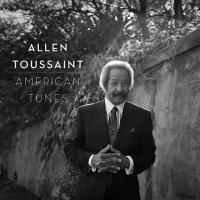Toussaint also wrote under pseudonyms such as Naomi Neville (A Certain Girl).
"American Tunes" Is Allen Toussaint's Most Generous Posthumous Musical Gift
He was a songwriter and producer in the ‘60s and ‘70s, working on ear catching tunes like Ernie K-Doe’s “Mother-in Law”, Lee Dorsey’s “Working in a Coal Mine” and others that gave a broad swatch of young America a taste of New Orleans, even if the demographic didn’t recognize the origin until many years later.
He was the house producer, arranger and songwriter for the Minit label, working with Irma Thomas, Aaron Neville and others.
Toussaint wrote the catchy-as-the-clap “Java”, that in 1963 Al Hirt—another New Orleans native— turned into a huge world-wide hit. His song “Fortune Teller” was recorded by The Rolling Stones, which must have delivered to Toussaint a nice, reoccurring royalty check.
In the ‘70s his Sea-Saint Studio was a popular recording venue for artists like Robert Palmer (who covered Touissant’s “Sneakin’ Sally Through the Alley”), Dr. John, Labelle, The Meters and Paul McCartney. “What Do You Want the Girl to Do?” was covered by everyone from Bonnie Raitt to Boz Scaggs to Elvis Costello.
Costello’ post Katrina Touissant collaboration The River In Reverse came years after his Edsel records reissued Southern Nights one of Toussaint’s ‘70’s era Warner Brothers releases.
Touissant’s studio and most of his possessions were lost in Katrina, which of course was tragic, but it helped bring about his performing career, which blossomed late in life when he toured the world with Elvis Costello.
His 2009 album The Bright Mississippi (Nonesuch 480380-1) featuring Don Byron, Nicholas Payton, Marc Ribot and other jazz stalwarts, was, like this record, brilliantly produced by Joe Henry.
In November of 2015 after a concert in Madrid, Touissant suffered a heart attack and died. He was seventy-seven.
While Toussaint embodied the rollicking New Orleans style, his was an elegant, well-mannered, polished version, well-represented on this recital-style album released after his passing. He plays solo on many tracks and his joined on others by a small group that includes Charles Lloyd, Bill Frisell, drummer Jay Bellerose and bassist David Piltch. Also here are Rhiannon Giddens and Van Dyke Parks.
He sings only one song here: a moving, earthy rendition of Paul Simon’s “American Tune”—the final song recorded at the last session before he passed away.
Toussaint covers “Fats” Waller, Earl “Fatha” Hines, Billy Strayhorn, Duke Ellington and even a non-waltz time version of Bill Evans’ “Waltz For Debby”, among others. Side four of the two LP set consists of three bonus tracks unavailable elsewhere, including a cover of “Moon River”.
Solo piano tracks were recorded at Toussaint Sound Studios in New Orleans. Everything else was recorded at United (formerly Ocean Way) in Los Angeles.
The sonics here are spectacular. While the piano sound is from the performer’s perspective (you hear what his left and right hands are playing) engineer Ryan Freeland gets a magnificent piano sound, with plenty of room sound behind to create the sensation of being in the room watching Touissant play. It’s a record you’ll feel privileged to repeatedly experience.
Highest recommendation.
- Log in or register to post comments


I agree re the music on this release (and the prior). However, I'm on my third copy, and I've not been able to find one that didn't have either: the same record inserted twice; lots of crackles and pops, despite my cleaning with AIVS and LAST products. So there appears to be garbage baked into the vinyl.
I gave up and gave in on the third try.

I met him once in my favorite NOLA restaurant, The Bon Ton (corner of Magazine and Natchez.) I recognized him and asked the waitress who encouraged me to approach him. He ended up coming to our table, sitting with us and talking for awhile. Such a classy gentleman-Mr. New Orleans! I agree on "The Bright Mississippi" sonics and material are great. I'll be getting a copy of this one too.

Great album! Thanks for pointing it out. I just ordered The Bright Mississippi, on your suggestion. I guess the old saying "Ya don't know what ya got till it's gone" is extremely retentive in this case.




